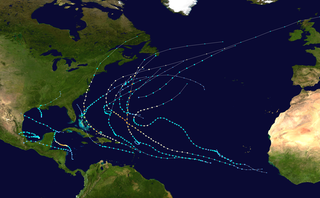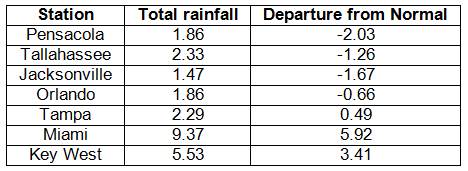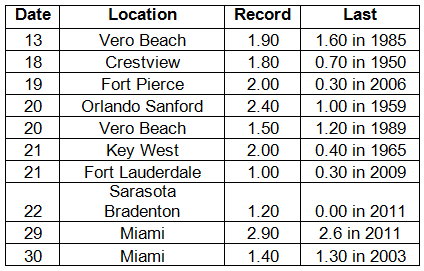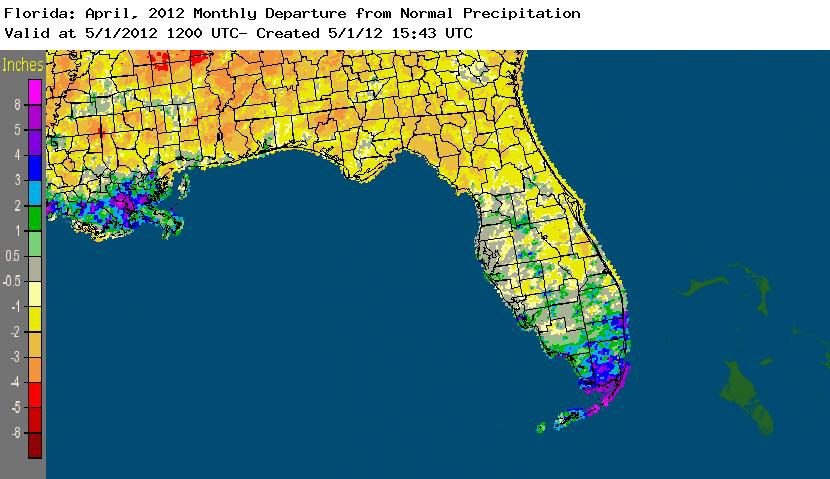| Quick Facts | |
1,179 Registered FL Observers
471 Active FL Observers
11,115 FL Reports Submitted during 4/12
Greatest # of Daily Reports Submitted during April: 406 on 4/22/12
Most Rainfall Reported during April: 7.85" on 4/21/12 from Station FL-MN-8
|
|
|
|
2012 Hurricane Season
|
 The 2012 Hurricane Season starts June 1st... Are you prepared? Some forecasters believe this year will be "near-normal" with 4 or more hurricanes, with 2 of those possibly being major hurricanes (Category 3 or higher). The last direct landfall of a hurricane in the state was Hurricane Wilma in 2005, but those of us who lived through or remember Tropical Storm Fay in 2008 know it doesn't take a hurricane to cause problems and havoc. It's been a while since the state has had to deal with any sort of real hurricane threat, but we know what can happen if we aren't prepared. So please, take a couple of minutes and visit the websites created by the Florida Division of Emergency Management. Based on your needs and responses, a checklist and additional information will better help you prepare. The 2012 Hurricane Season starts June 1st... Are you prepared? Some forecasters believe this year will be "near-normal" with 4 or more hurricanes, with 2 of those possibly being major hurricanes (Category 3 or higher). The last direct landfall of a hurricane in the state was Hurricane Wilma in 2005, but those of us who lived through or remember Tropical Storm Fay in 2008 know it doesn't take a hurricane to cause problems and havoc. It's been a while since the state has had to deal with any sort of real hurricane threat, but we know what can happen if we aren't prepared. So please, take a couple of minutes and visit the websites created by the Florida Division of Emergency Management. Based on your needs and responses, a checklist and additional information will better help you prepare.
Create a Hurricane Plan for:
Your Family: http://www.floridadisaster.org/family/
Your Business: http://www.floridadisaster.org/business/
You can find the contact information for your County Emergency Management Office here:
http://www.floridadisaster.org/County_EM/county_list.htm
In the event of a land-falling tropical system, you can remove the funnel and inner tube of your rain gauge so that they do not become flying hazards during the storm. However, if you are worried it could be damaged or lost should a hurricane threaten your area, you can take it down. Remember - your safety is our number one concern, so please take heed when officials issue evacuations for your area. Rain gauges can be replaced but you cannot.
|
|
April Rains
|
Rainfall totals varied statewide in April (Table 1). Most stations saw below normal rainfall, while Key West, Miami, and Tampa saw above normal rainfall totals. April 2012 was the 7th wettest on record at Miami and was the 6th wettest April from the 142-year-long record at Key West. Heavy rains mainly impacted southeast portions of the state during two separate rain events, and some rainfall records were broken toward the end of the month (Table 2). Areal patterns of monthly rainfall relative to normal are depicted in Figure 1.
| Table 1: April precipitation totals and departures from normal (inches) for select cities. |
|  |
|
Table 2: Select daily rainfall records (inches) broken during March (compiled from NOAA, NWS).
|  |
|
|
Figure 1: A graphical depiction of the monthly rainfall departure from normal (inches) for April (courtesy of NOAA, NWS)
|  |
|
|
April CoCoRaHS Totals
|
Here are the CoCoRaHS rainfall totals for April from some select CoCoRaHS stations across the state.
| |
|
Current State of the Drought
|
Since the release of the March 27 Drought Monitor, conditions have worsened across most of the state. As of April 24, nearly 12% of the state is listed as being in exceptional drought, the highest designation of the drought monitor. This area of exceptional drought extends from portions of the Nature Coast to the First Coast, impacting locations such as Lake City, Gainesville, and Jacksonville. Parts of the Suwannee River are at some of the lowest flows seen on record. The areas of moderate and extreme drought grew as rainfall was below normal in central Florida and parts of the Big Bend. The only part of the state that saw any improvement in conditions was south Florida, where portions of the area had almost double the normal monthly rainfall for April. The Climate Prediction Center (CPC) is calling for near normal rainfall through July; however, May is typically one of the driest months for many locations across the state.
The National Drought Monitor is updated weekly, so you can always check the most recent conditions here: http://www.drought.unl.edu/dm/DM_state.htm?FL,SE.

|
|
|
Odds and Ends
|
Work has been completed on a new Florida Climate Center website at http://climatecenter.fsu.edu. We will be adding new tools to the website over the next few months. Recently, a new tool was added that investigates the occurrences of a 'big rain' event at a variety of stations across the southeast. Take some time to play around with the tools that are available through the Florida Climate Center.
You can now 'Like' Florida CoCoRaHS on Facebook! By joining our Facebook page, the latest Florida CoCoRaHS news items will automatically show up in your "news feed" when you first login to Facebook. To join, click the "Find us on Facebook" link in the menu bar of this email, then click the "like" button on our Facebook page.
This year, I was able to participate in Take Your Child to Work Day and had my wonderful daughter come in and help me for a day around the office. She thought she'd get away with playing around on the computer, but, to her surprise, I had things for her to do. She worked on putting together some of the information for the precipitation table and rainfall records and helped figure out the Quick Facts for this newsletter. She proved to be a huge help, and I might have to make this a monthly routine for her.
| |
|
Thank You!
Thank you for your continued support and enthusiasm! If at any time you have questions about CoCoRaHS, reading your rain gauge, or finding a location to setup your rain gauge, please feel to contact a Florida CoCoRaHS Coordinator. We are lucky enough to have regional support from National Weather Service offices across the state, as well as county/local help from several CoCoRaHS volunteers.
 Melissa Griffin Florida CoCoRaHS State Coordinator Assistant State Climatologist Florida Climate Center/Center for Ocean-Atmospheric Prediction Studies Florida State University 232 R.M. Johnson Building Tallahassee, FL 32306-2840 (850) 644-0719 griffin@coaps.fsu.edu | |
|